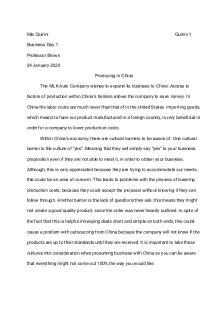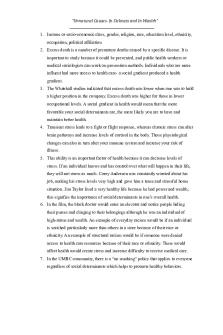Video Critique for In Sickness and in Wealth Essay- 97 PDF

| Title | Video Critique for In Sickness and in Wealth Essay- 97 |
|---|---|
| Course | Sociology of Health and Illness |
| Institution | University of Louisville |
| Pages | 6 |
| File Size | 84.1 KB |
| File Type | |
| Total Downloads | 86 |
| Total Views | 139 |
Summary
Potter essay about assigned documentary. I needed to include more detail for additional three points...
Description
Stu Dr. Potter SOC 435 12 Nov. 2020 In Sickness and In Wealth Video Critique Health and socioeconomic status are intrinsically linked as explored in the documentary In Sickness and in Wealth. This linkage comes from the effects that stress from lower socioeconomic status can cause as well as the opportunities to preserve and increase health that are unavailable to those in lower socioeconomic statuses. These effects cycle through generations as socioeconomic status in childhood creates lasting changes in the brain despite upward societal movement. In Sickness and in Wealth explores how these factors that seem to be far from physical create lasting medical differences in the lives of patients as well as possible ways to combat the recurring cycle of declining health. In my analysis I seek to unite these ideas with the sociological concepts of deprivation amplification and the need hierarchy in regards to illness. In the documentary, a middle-aged woman, Mary, discusses how she doesn't have the resources in her community that some others do. Indeed, her community mainly consists of fast food restaurants, cash advance locations, pawn shops, and liquor stores (In Sickness and in Wealth) which is a far cry from an area full of clinics and large grocery stores. Her community suffers from deprivation amplification in "which a range of resources and facilities which might promote health are less common in poorer areas" (Ellaway and Macintyre 7). Ellaway and Macintyre focus on this community state in their chapter, Neighborhood Influences on Health where the consequences of this deprivation are discussed. Without these resources, it becomes more difficult to access healthcare, but also to access materials that can prevent poor health.
When the documentary showcases Mary, she is at a local discount food-chain purchasing processed meals for her family (In Sickness and in Wealth). "'You have to eat what fits your budget'", Mary explains as she discusses how she must choose a frozen meal over cooking a meal that would prove much more expensive (In Sickness and in Wealth). Even if Mary wanted to cook with fresh ingredients, they are nowhere to be seen in the discount store's background behind her (In Sickness and in Wealth). This is not an isolated incident, as many people in lower socioeconomic areas live in similar food desert situations and must choose cheap processed foods over homemade, healthy meals (Ellaway and Macintyre 8). In addition, exercise locations are scarce in lower-income communities (Ellaway and Macintyre 8) and even walking can prove a challenge in more dangerous areas (In Sickness and in Wealth). While the documentary focuses on a single woman for storytelling reasons, Ellaway and Macintyre's research shows the overarching societal pattern that reflects Mary's situation. Families in lower socioeconomic classes routinely experience deprivation amplification in their communities. As Mary showed during her time in the film, many families in lower socioeconomic levels are unable to fulfill what others take for granted. At one point, Mary states that she must "'reduce to about one meal a day so that [her kids] can eat'" due to their lack of income to purchase food (In Sickness and in Wealth). Food is undoubtedly needed for survival, and thus is a basic need on the needs hierarchy. This system, defined by McKinlay in A Case for Refocusing Upstream: The Political Economy of Illness, creates a range of importance in securing needed items with survival objects such as food and shelter as most important and items such as social relationships and exercise as secondary, less-obviously important needs (McKinlay 103). One's ability to secure primary needs allows them to move to secondary needs, and this ability "is largely a function of the shape of the existing social structure and aspects of socio-economic
class" (McKinlay 103). As seen with Mary, since food is a main concern for her family, she never has time to build social relationships or relax on a vacation (In Sickness and in Wealth). She, and many others who live at or below poverty levels, is unable to fulfill secondary needs when her primary, survival needs are unmet due to societal burdens (McKinlay 103). By using the readings mentioned above, it becomes clear how living in lower-income communities or even surviving on low wages in a higher-income community can affect public health. By living in a state of constantly being unable to fulfill basic needs, "the stress response [kicks in]" which puts the body in a constant state of fight-or-flight (In Sickness and in Wealth) . Experiencing this response for an extended amount of time raises blood pressure, causes variability in heart rate, creates glucose processing problems, and accelerates aging (In Sickness and in Wealth). By being unable to focus on secondary needs, lifespans become shortened since the constant stress ages at a faster pace than those in better situations. By analyzing the concepts above, we can see how healthcare becomes practically unattainable to those in areas of lowered socioeconomic status. Sociologists and scientists alike know the factors that reduce risk in a population. Education, exercise, food, and even vacations can reduce stress and increase life spans for people in a community (In Sickness and in Wealth). Unfortunately, barriers stand in the way or accessing these items. The severe deprivation amplification in lower income communities make it difficult to fulfill basic, primary needs in the needs hierarchy. For example, if your area exists within a food desert, it is hard to acquire all the needed nutrients without a lengthy journey to another city (Ellaway and McIntyre 7). This burden keeps people from addressing secondary needs, such as exercise and maintaining healthy social relationships (Mcintyre 103). This, in turn, elevates stress levels, which cause a myriad of health issues and lead to a higher likelihood
of falling ill (In Sickness and in Wealth). It becomes even more apparent through these concepts that "'life dependency [is] dependent on … the resources you have available to you'" (In Sickness and in Wealth). A strong community foundation that works to provide resources that can satisfy primary needs can give people the freedom to fulfill secondary needs and take charge of health. This can be seen in other communities globally with stronger social support programs (In Sickness and in Wealth). In Sickness and in Wealth is a very factual documentary and does a good job presenting statistics about the effects that income has on health. It has a sound sociological base as it surrounds the process of interest at a macro-level of communities around a city as opposed to at the individual familial level. While there is focus given to families in particular, these exist to create a relationship with the topic and people it affects as opposed to maintaining a sense of distance from the topic in viewers. While statistics are very clearly shown in the video comparing council districts, there is a need for more details defining the composition of each council district. Race is touched on near the end of the program, but there isn't talk about how systemic racism plays into the divide in healthcare. In addition, there isn't elaboration on the way that healthcare is tied to employment so that those in poor working conditions are tied to a job for fear of losing healthcare, which creates more stress and medical problems. While the individual stories told are very interesting, I worry about the representativeness of the families shown. There isn't much racial equality in the sample shown despite the diversity available in Louisville and all the interviewees are middle-aged or older. More perspectives could aid in generalizability to all of Louisville. In addition, Louisville is one city in a large country and exists in a liberal area which is willing to invest in the community to build health. Other areas of
the country are not as fortunate. While I understand the constraints the documentary was under, a more diverse sampling of participants would make the piece more sociologically relevant. Healthcare and community are inseparable, and understanding how the two intertwine is essential to reducing illness. In Sickness and in Wealth examines this connection which is strengthened by sociological concepts of deprivation amplification and the needs hierarchy. Through community outreach, as seen in the documentary, primary needs can be met which allow the time for secondary needs to be satiated. This outreach is necessary to cultivate healthy, resilient communities for all inhabitants, not just the affluent. Wealth should never be the determining factor of health.
Works Cited “In Sickness and in Wealth.” Smith, Llewellyn M, director. Unnatural Causes, season 1, episode 1, PBS, 2008, louisville.kanopy.com/video/sickness-and-wealth. Macintyre, Sally, and Anne Ellaway. “CHAPTER 5: NEIGHBOURHOOD INFLUENCES ON HEALTH.” Blackboard, 2020, pp. 1–17, blackboard.louisville.edu/ultra/courses/_1635159_1/cl/outline?legacyUrl=%252Fwebapp s%252Fassignment%252FuploadAssignment%3Fcontent_id%3D_17830980_1%26cours e_id%3D_1635159_1%26group_id%3D%26mode%3Dview. McKinlay, John B. “A Case for Refocusing Upstream: The Political Economy of Illness.” Patients, Physicians and Illness: A Sourcebook in Behavioral Science and Health, edited by Peter Conrad and Valerie Leiter, The Free Press, 1979, pp. 9–25....
Similar Free PDFs

African sleeping sickness essay
- 14 Pages

Essay 2 - Grade: 97
- 6 Pages

Analysis Essay - Grade: 97
- 3 Pages

Essay 1 - Grade: 97
- 5 Pages

Video Critique Part 1 &2
- 1 Pages

EBP Critique Essay
- 8 Pages

Sexism in Hollywood Essay
- 10 Pages

Accountant IN Business Essay
- 32 Pages

In Class Essay 1
- 2 Pages

Producing in China Essay
- 3 Pages
Popular Institutions
- Tinajero National High School - Annex
- Politeknik Caltex Riau
- Yokohama City University
- SGT University
- University of Al-Qadisiyah
- Divine Word College of Vigan
- Techniek College Rotterdam
- Universidade de Santiago
- Universiti Teknologi MARA Cawangan Johor Kampus Pasir Gudang
- Poltekkes Kemenkes Yogyakarta
- Baguio City National High School
- Colegio san marcos
- preparatoria uno
- Centro de Bachillerato Tecnológico Industrial y de Servicios No. 107
- Dalian Maritime University
- Quang Trung Secondary School
- Colegio Tecnológico en Informática
- Corporación Regional de Educación Superior
- Grupo CEDVA
- Dar Al Uloom University
- Centro de Estudios Preuniversitarios de la Universidad Nacional de Ingeniería
- 上智大学
- Aakash International School, Nuna Majara
- San Felipe Neri Catholic School
- Kang Chiao International School - New Taipei City
- Misamis Occidental National High School
- Institución Educativa Escuela Normal Juan Ladrilleros
- Kolehiyo ng Pantukan
- Batanes State College
- Instituto Continental
- Sekolah Menengah Kejuruan Kesehatan Kaltara (Tarakan)
- Colegio de La Inmaculada Concepcion - Cebu





